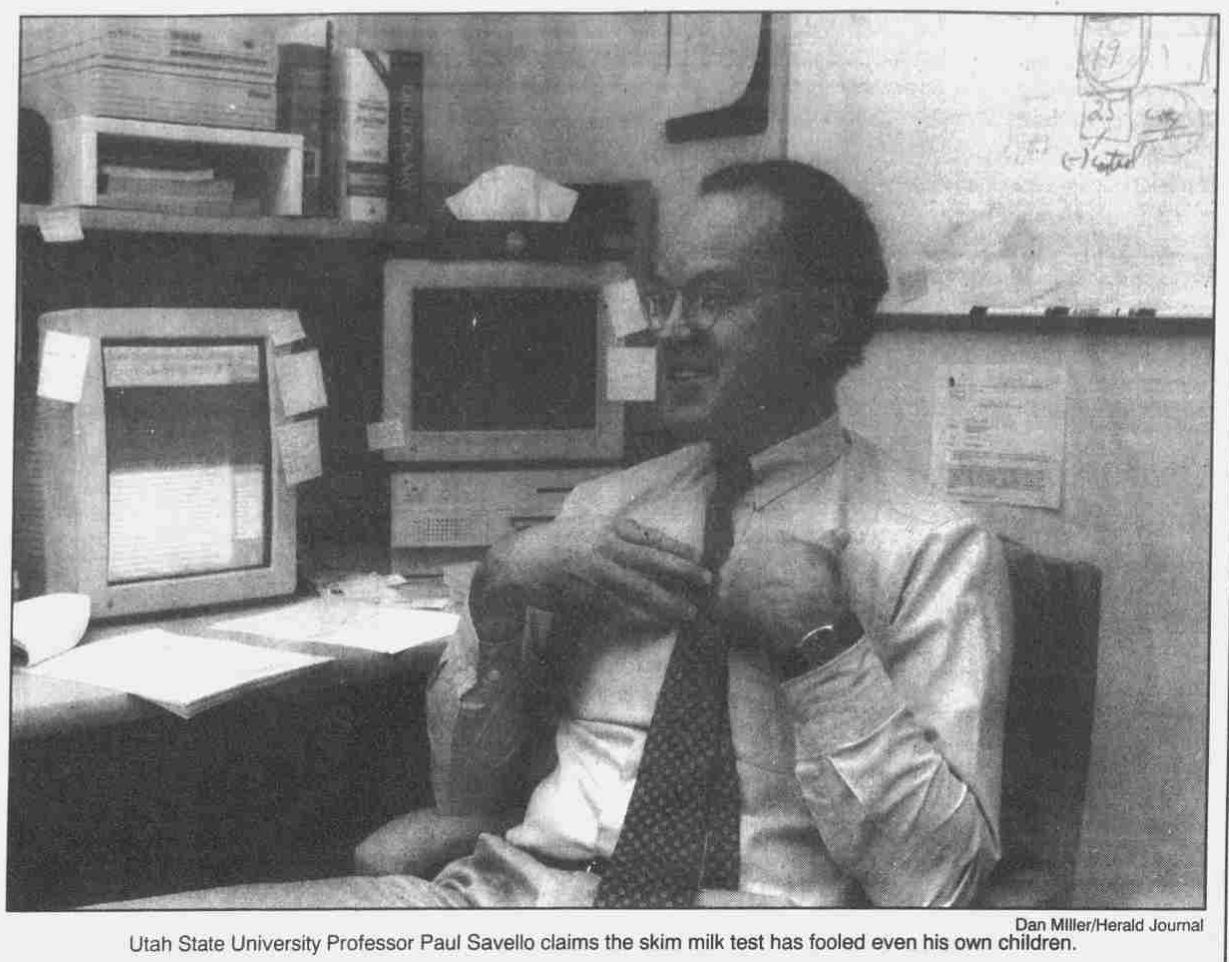
Logan Herald Journal | 1994-11-06 | Page 38
Most people are probably pretty sure they can tell skim milk from 2 percent or whole milk with their eyes closed. Skim is the thin stuff that even cats turn down right?
Wrong, according to Paul Savello a professor in Utah State University’s Nutrition and Food Sciences Department. Savello is positive if he blindfolds you, you won’t be able to taste a difference.
The impression that skim milk is thin, he says, comes when people see the bluish tint and assume it will taste watery. And he has a solution to the “tastes less filling” problem.
Savello and USU took out a patent this year on a process that whitens skim milk, and they're now talking with several companies about marketing it.
“You see the color (of skim milk) and think ‘this is going to be watery,’” he says. But blind-taste tests at USU and other universities show people have trouble discerning skim and 2 percent milk without the “visual cue” of blueness, Savello says.
He even tried the ultimate experiment —Savello youngsters should skip this next part — he filled some 2 percent jugs with the treated skim milk and took it home
“They didn’t say anything, they just drank it” he says with a smile.
The missing puzzle piece was rennet, the enzyme used to coagulate milk into cheese. Researchers add an “incredibly tiny” amount of rennet to the skim milk for just an instant before heating the milk to halt thickening.
The enzyme makes light reflect differently to mask blueness without altering the taste or the chemical balance. Using a dairy-related product to add whiteness was crucial. Savello says because of strict labeling restrictions. A change of ingredient require renaming the product something like “milk drink” — not a positive sales point.
People in Utah’s dairy industry recognized Savello’s efforts by awarding him the 1994 Service To Dairy Industry Award. Karen Barker, head of Dairy Farmers of Utah, called Savello “a credit to the industry.”
“The research he’s done has been tremendous to the dairy industry as a whole, not just Utah” she said. “We don’t award (the Service award) if we don’t have a quality winner, and Paul was unanimous.”
Researchers have been toying with milk coloration for years, but apparently no one had tried rennet until a USU graduate student casually suggested it to Savello. Once the apple fell on their heads, he says the theory was “so simple it’s ridiculous.” Now the task is to make sure the process can be done on a large scale, and to find a producer to market the idea.
USU owns the patent, so the school will receive royalties if and when the new milk hits store shelves. A percentage of those royalties goes to the inventors, too, but Savello said the point of marketing a product is to bring money in to do more research.
He thinks university research is evolving from “esoteric” studies that had nothing to do with the general public to more applicable work. Food researchers do have one advantage over scientists in more abstract fields, he says: people can taste your results.
“Food science is unique, because your research projects do become an edible item,” Savello says. “Most people can grasp our ideas because everybody eats.”
USU, as one of six federally supported “dairy centers for excellence” in the US., is hosting a number of other dairy food projects including:
- Concentrated milk — milk concentrated, in liquid form to half its original volume The “just add water” milk is great for astronauts and long-distance shipping, without the problems of powder.
- Low-fat cheese — cheese that looks and tastes like regular cheese, but with half the fat. Professor Don McMahon, who is also director of the National Dairy Center, leads the study.
- Iron-fortification — dairy foods are rich in virtually all nutrients except iron. This project is focused on adding iron to mozzarella cheese and yogurt, favorites of many young women, a group often at risk of low iron problems.
- Non-refrigerated milk — already available, but USU is concentrating on ways to make it more convenient to store, ship, and display.
Savello says the “technology transfer” from scientist to consumer is improving, as researchers concentrate on more useful studies.
“The good times of just being able to do nice little things are over,” he says. “We try to work on ideas to show a concept. Then the trick is to get somebody to pick it up and run with it.”

